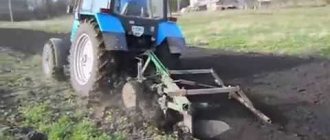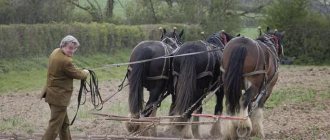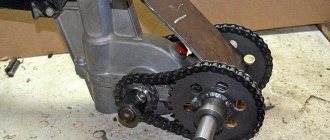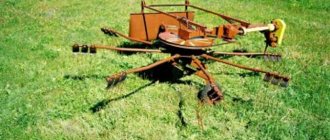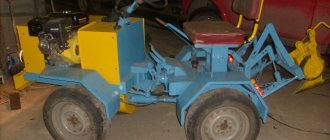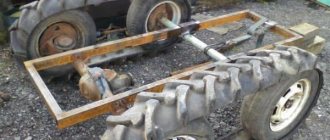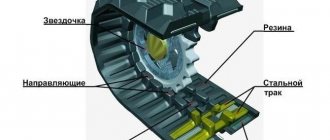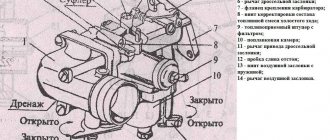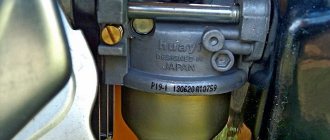The first devices for harrowing appeared from the time when man first learned to cultivate the land with a primitive wooden plow (ploughshare). Harrows were also made of wood and were not very long, for greater maneuverability, but heavy enough, which made it possible to crush large clods of earth formed after plowing.
Homemade classic (tooth) harrow for walk-behind tractor
Tractors have long since replaced horses, and harrows have become more advanced and efficient, and can be installed not only on heavy and medium-sized agricultural equipment, but also on mini-tractors and walk-behind tractors. This type of equipment allows you not only to break up large clods and cover the soil to retain moisture, but also to collect the remains of dry vegetation, as well as remove its roots.
The following types of harrows exist:
- dental or classic;
- rotary or rotary;
- disk.
According to this classification, harrowing attachments are heavy, medium and light. You can buy a harrowing device for the Neva walk-behind tractor at a specialized store or make it yourself.
Tooth harrow for walk-behind tractor Rotary harrow for walk-behind tractor Disc harrow for walk-behind tractor
Configuration errors
As Alexander Ladygin notes, a correctly selected disc harrow does not need any adjustments (except for setting the working depth and leveling the horizon using the tractor hitch or the hydraulic drawbar of the implement itself).
At the same time, they note that one of the characteristic errors in the operation of disc harrows, especially double-row ones, is the uneven penetration of the working parts of the machine. Namely, the excessive deepening of the front row of the disk battery.
According to the observations of Vasily Lebed, many agronomists insist on such adjustment, arguing that the front row of discs works with a denser soil layer than the rear one.
However, if you configure the disc harrow in this way (the front row is lower), then, given that the front discs are already working in denser soil, it turns out that the machine will “lead” at an angle to the line of travel, either to the right or to the left, depending on Vyacheslav Veklenko explains in which direction the front row of discs is directed.
In addition, both the frame itself and the bearings on the front row of the disk battery suffer, which fail faster, the representative adds. And the rapid and frequent failure of the bearings in the first row of the battery indicates that it was too deep and unevenly buried relative to the rear row and took on the entire load.
Here, rather, the opposite is recommended: to shallow out the front row of discs a little in order to level out the soil resistance to cultivation for the front and rear row of discs, which goes along the already “opened” layer, argues Vyacheslav Veklenko. But what the difference in the stroke depth of disk batteries should be cannot be rigidly determined by a “tabular method”; this is precisely the case for fine adjustment in the field.
Rotary agricultural implements
If we talk about a rotary harrow for a walk-behind tractor, its main advantage is the optimal removal of the top layer of soil. Leveling the ground with her participation is also not a question. The depth of loosening the soil ranges from 4 to 8 centimeters; it can be adjusted, taking as a basis the specific features of the work.
The width of the harrow is also very important; not only the resource of the walk-behind tractor is taken into account here, but also the area of the cultivated area. As a rule, this value is 800–1400 millimeters. Such parameters are explained by the ability to work comfortably while maneuvering in areas with a small area.
Industrially manufactured rotary harrows are made of a high-quality metal alloy, which makes it possible to actively use the equipment for decades (with appropriate care and maintenance).
On high-quality agricultural implements, the blade has an oblique configuration, and the teeth are at an angle to the ground, having an ideal penetration angle for high-quality cutting of the soil, leveling it and eliminating weeds.
Design features of a homemade harrow
The optimal and simplest option for making it yourself is a tooth harrow. To create it, you will need to carefully study the drawings, which should indicate the sequence of actions when assembling the equipment
It is also very important that the diagrams indicate the dimensions of all parts used for the manufacture of the harrow
The design itself, in appearance, resembles a frame cage to which the teeth are attached using bolts. The front part of the structure must be equipped with a towing device, which, in most cases, takes the form of a hitch with holes. When installing on a walk-behind tractor, the hitch will need to be inserted into the tow bar pipe, and then secure both elements with a finger
It is extremely important to weld a special chain between the tow bar and the hitch, which will make working with the equipment easier
The cage of the tooth harrow should be as strong as possible, so for its manufacture you should use square or water pipes, as well as corners to strengthen the joints of the structure. Each part must be made of steel with a thickness of at least 5 mm, otherwise the soil will tear out the teeth along with pieces of metal.
The design of the manufactured grating must consist of transverse and longitudinal parts. At the same time, the best option would be a cage in which the rods are welded together at an angle of 45⁰ relative to the direction of movement of the walk-behind tractor. Such a homemade harrow will be subject to much less bending loads.
To determine the size of the cells, you will need to first determine how the teeth will be placed on the harrow. To do this, you need to draw the teeth on the drawing, and on top of them draw a grid on which they should be attached. The frame itself must be of such dimensions that it does not subsequently interfere with working with the walk-behind tractor
It is also extremely important to take into account the dimensions of the coupling device in a timely manner. It must be remembered that many walk-behind tractors simply cannot pull a harrow more than 1 m wide.
It is best to use corrugated reinforcing steel to make teeth. Its diameter should be at least 18 mm, and the length of each tooth made should be about 15 cm. The height of the tooth does not depend on the height of the coupling device, since the homemade harrow will be attached to the walk-behind tractor using a chain. In this case, the thickness of the latter should be increased if thick teeth are attached to the harrow.
For areas with difficult terrain
You can make your own tooth harrow with a slightly more complex design. It will work perfectly as a light harrow for breaking up capillary crusts and also for killing weeds. A special feature of its design is the articulation of the elements.
Such a tool will do an excellent job of weeding precisely because of its segmented structure - not a single depression or convexity of the sown area will be left without the “attention” of its teeth.
The benefits of loosening
The year before last and the beginning of the last century, people already knew about the benefits of spring and autumn loosening. Then the soil was cultivated with a wooden tool - a harrow. It was made from parts of thin spruce logs, connected to each other and having a common base. Now such harrows can only be seen in the halls of local history museums. Nowadays in the agricultural industry, rotary tillers or harrows are used for loosening. In addition to the destruction of the soil crust, the following occurs:
- thickened seedlings of crops are thinned out;
- weed seedlings die;
- the surface of the area is leveled;
- clods of earth are broken;
- the plowed field is prepared for sowing seeds;
- The soil on the pasture is loosened, which ensures the friendly germination of forage plants.
Loosening can be carried out immediately after plowing, and after this the area is rolled. It also happens that these activities are carried out with an interval of 2-3 days. This is not critical unless the weather is hot and dry. As a result of rolling and harrowing, the surface layer of soil becomes smooth, which makes it easier to plant seeds.
Loam is considered the easiest to cultivate. This is a fertile, light and at the same time porous soil that can retain a lot of moisture. Sandy loam and sandy soil, on the contrary, dry out quickly and have low fertility. On such soils, a slight delay in loosening, which is sometimes incorrectly called armoring, contributes to a decrease in yield. Harrowing is divided into several types:
- Early spring. They are carried out through the black fallow and plowed soil as soon as the physical ripeness of the soil occurs. In arid zones, needle harrows are used; in areas with normal moisture, tooth harrows are used.
- Pre-sowing. Heavy disc harrows are used. This agrotechnical technique is practiced in the southern regions to prepare the soil for sowing grain. It is practiced in a cultivated field and is often combined with cultivation. Loosening with simultaneous sowing is possible, with a seeder attached to the tractor.
- Processing of winter crops, shrubs and fruit trees. Hoes and small and medium harrows are used. Loosening stimulates microbiological processes.
- Post-sowing. Two harrowing operations are carried out: before and after germination. The first destroys 85-95% of weed seedlings. During the second, the soil is loosened, which ensures free access of oxygen to the roots of the grain. Weeding, rotating, mesh and tooth tools are used.
- Summer. Harrowing is carried out by rocker and clean pairs. Task: loosen the soil, remove grass shoots.
- Semi-steam. Performed across rows or plowing, using tone or diagonal implements. Often harrowed in conjunction with cultivation, hoeing or plowing. Small areas are treated with circular movements around the perimeter.
When harrowing, the most important thing is to meet deadlines. If you are late, the soil will dry out and the treatment will not have a pronounced effect.
Yields on fields that were not harrowed in a timely manner or were done incorrectly are usually lower. In addition, it is important that the harrow matches the characteristics of the soil. Hitches must be universal or have a working width of at least 21 m.
An alternative method for growing potatoes without weeding
Several years ago, in the Siberian region, a method for cultivating potatoes without the need for hilling and weeding was developed. The method is based on the use of organic farming and green manure plants.
To grow potatoes without weeding, you need to prepare beds the width of which does not exceed 0.8 m, and make the row spacing the same size. The passages must be thoroughly mulched with hay or straw, and the mulching layer must be replaced with a fresh one weekly. In the last month of summer, green manure is sown on strips under mulch. It is advisable to use mustard, radish or oats as green manure plants, which increase the fertility of the soil in the potato area.
No less popular is an alternative method of growing potatoes in vertical containers, which can be used in almost any volumetric container, including garbage bins and bags, garden barrels and relatively tall homemade structures.
You can avoid large-scale weeding activities if you mulch the rows with black agrofibre. In this case, between potato bushes in a row, single weeds will be removed manually at the seedling stage.
Features of harrowing
Harrowing is considered the most important stage of soil cultivation, on which the condition of crops and the yield of cultivated crops depend. This agrotechnical measure solves several problems at once, the main ones being the destruction of weeds and loosening the soil. In addition, harrowing effectively levels the ground and significantly reduces moisture loss. The loosening effect is achieved due to the impact on the soil of working elements mounted on a common frame and shaped like disks, teeth or hoes.
Such a device is called a harrow and has been known to mankind since ancient times. Previously, dragging a harrow was the lot of workhorses, but today, thanks to the mechanization of the process, this role is assigned to agricultural machinery.
The harrowing process is carried out twice a year. The first time - in early spring, immediately after the soil thaws, and the second time - after the last harvest, shortly before the first frost.
Rotary device type
These devices are mainly called not just harrows, but harrow-hoes. They are used mainly in areas of insufficient moisture, as well as in conditions when cultivated plants are passing the phase of possible use of tooth harrows.
A rotary harrow consists of pairs of discs that are located on horizontal axes. The disk has wedge-shaped teeth with beveled cuts. The working width of these types of harrows ranges from 1.1 to 18.3 m.
With the help of rotary harrows you can apply fertilizers and crop residues. The processing depth can be up to 28 cm (for Polish models).
Specifications by model
All-frame disc harrows, mounted
| Model | Number of disks | Width | Tractor power | Weight | Area |
| Paper machine – 1.8x2 N | 12 pcs | 1.62 m | 50¸ 60 l/s | 750 kg | 2.19 ha/hour |
| PM – 2.0x2 N | 14 pcs | 1.88 m | 60/70 l/s | 850 kg | 2.54 ha/hour |
| Paper machine – 2.2x2 N | 16 pcs | 2.04 m | 70/80 l/s | 940 kg | 2.75 ha/hour |
| Paper machine – 2.4x2 N | 18 pcs | 2.30 m | 70/90 l/s | 1093 kg | 3.11 ha/hour |
| Paper machine – 3×2 N | 22 pcs | 3.00 m | 90/120 l/s | 1265 kg | 4.05 ha/hour |
| Paper machine – 4×2 N | 30 pcs | 3.76 m | 120/150 l/s | 1680 kg | 5.08 ha/hour |
Semi-trailer modular and solid frame
| Model | Number of disks | Width | Tractor power | Weight | Area |
| Paper machine – 3x2 P | 22 pcs | 2.82 m | 90/120 l/s | 2400 kg | 3.78 ha/hour |
| Paper machine – 4x2 P | 30 pcs | 3.86 m | 120/160 l/s | 2910 kg | 5.21 ha/hour |
| Paper machine – 5x2 P | 38 pcs | 4.90 m | 150/190 l/s | 3650 kg | 6.62 ha/hour |
| Paper machine – 6x2 P | 46 pcs | 5.94 m | 180/230 l/s | 4160 kg | 8.02 ha/hour |
Semi-trailer, sectional
| Model | Number of disks | Width | Tractor power | Weight | Area |
| Paper machine – 6x2 pcs | 46 pcs | 5.94 m | 180/230 l/s | 4640 kg | 8.02 ha/hour |
| Paper machine – 7x2 pcs | 54 pcs | 6.98 m | 220/270 l/s | 5100 kg | 9.42 ha/hour |
| Paper machine – 8x2 pcs | 62 pcs | 8.02 m | 250/310 l/s | 5655 kg | 10.83 ha/hour |
| PM – 9x2 pcs | 66 pcs | 8.55 m | 300/330 l/s | 5900 kg | 11.54 ha/hour |
Semi-trailer type "Butterfly"
| Model | Number of disks | Width | Tractor power | Weight | Area |
| PM – 4x2 B PC | 30 pcs | 3.86 m | 120/160 l/s | 3433 kg | 5.21 ha/hour |
| PM – 5x2 B PC | 38 pcs | 4.90 m | 150/190 l/s | 3950 kg | 6.62 ha/hour |
| PM – 6x2 B PC | 46 pcs | 5.94 m | 180/230 l/s | 4390 kg | 8.02 ha/hour |
PLEASE NOTE: When selecting a disk drive for the MTZ or YuMZ tractor, it is necessary to check the tractor power with the characteristics given in the table
Manufacturing methods
Once you know what types of plowing products there are, you can make them yourself. True, you have to assemble it manually.
As a rule, factory harrows on a walk-behind tractor are made of special steel that can withstand high loads. The design of the product looks like a zigzag frame, which you can make yourself, having drawings and diagrams with you, as well as the necessary materials. To make a homemade harrow for a walk-behind tractor, you will need the following tools:
- steel strip:
- racks for coupling with a walk-behind tractor;
- and, of course, the teeth themselves.
Secure the teeth by welding. This can be done another way: weld the pins, cut threads on them, then fix the teeth on them with nuts.
Study diagrams and drawings to make a great device for your site. A special bushing must be attached to the drawbar of the equipment itself, with the help of which the connection is made with a small tractor. Make a stand with a screw so that in the future you can adjust the height level - this is the key to evenly immersing the parts into the ground.
https://youtube.com/watch?v=q9kaS3zqvvk
We can say that the most practical and lightest device attached to a walk-behind tractor with your own hands is a mesh harrow. However, farmers and gardeners are choosing a rotary harrow. Carefully study the diagrams and drawings that will help you make an excellent addition to your mini tractor.
What functions does the inventory perform?
The tasks of the harrow are quite extensive. Moreover, every year its design becomes more and more advanced, which allows it to be used for various purposes. Nowadays, the product is designed to solve the following problems:
- Preserving soil from drying out;
- Leveling the surface of the site;
- Effective weed removal;
- Destruction of the top layer of the earth.
Equipment of this type has found its use before sowing, when it is necessary to break up frozen pieces of soil and level the ground. Also, a harrow for a walk-behind tractor is used immediately after harvesting to prepare the area for wintering.
DIY tooth harrow
This device is easiest to make yourself. If you have metal materials, a grinder and a welding machine, then the process will not cause many difficulties.
To produce a harrow for a walk-behind tractor with your own hands, you need to understand the drawings and determine the required dimensions.
The design looks like a lattice with teeth welded to it. If possible, it is recommended to tighten them with bolts to ensure replacement in case of breakdown. A towbar to the walk-behind tractor must be provided in front. To facilitate work, a chain is welded between the two units.
The grille is made of durable materials. They mainly use water pipes and corners with a thickness of more than 4 millimeters so that the teeth do not come off the thin-walled base. A more reliable design involves welding the rods at an angle of 45 degrees to the movement, which reduces loads.
The size of the grid cells should correspond to the size of the teeth. The frame size is designed in such a way as not to interfere with the control of the walk-behind tractor.
To make teeth, reinforcement corrugated steel with a diameter of about 15 millimeters and a length of up to 200 is usually used. The smaller the tooth, the thinner it is. They are hardened before not being used for strength. When harrowing with a walk-behind tractor is carried out, for efficiency, the elements entering the soil are spaced a maximum of 1 centimeter apart. A slight shift is allowed to ensure greater intensity and quality of work. The build process looks like this:
- First you need to assemble and weld the grate.
- Then attach the teeth using welding or bolts. You need to measure accurately and do it at an angle of 90 degrees.
- At the approximate location of the center of force, it is necessary to weld a chain, one of the links of which is to the grid, the other to the hitch.
- The final stage will be to check the fastening when performing work, and when the harrow moves in any direction, the target is digested.
Regardless of whether the finished product was purchased or whether it was built independently, wet soil and residues of organic crops accumulate on the working elements. Therefore, you should periodically clean the teeth with metal objects or an appropriate scraper.
Assembly
Assembly is carried out after preliminary drawing and procurement of all parts. First, the grate is assembled and welded. After this, the teeth are welded to it. It is important to do this at a right angle. As a rule, hardened teeth do not anneal after welding and their strength does not change.
After this, it is determined where approximately the center of application of forces will be located and the chain is welded to this place. Take the first link of the chain and overlap it onto the grate.
After this, the second end of the chain is welded or bolted to the hitch.
The performance of the harrow is checked after fastening, and if necessary, the chain is welded to the left or right, if the harrow leads in one direction or another, then it is finally welded.
Check out other homemade accessories for walk-behind tractors.
Types of harrows
Harrows for agricultural work are divided into types:
- dental;
- disk;
- rotary.
A tooth harrow is a simple mechanism consisting of a metal frame with teeth of the required length attached to it. The power of the walk-behind tractor affects their number and frame size. The teeth are arranged in a zigzag or rectangular pattern and are attached to the frame rigidly, hingedly or on a spring strut.
The harrowing depth depends on the setting of the teeth. When they are installed with the sharp edge forward in the direction of travel, the depth of loosening increases; when installed backwards, it decreases.
A disc harrow differs from a tooth harrow in that it is a processing tool. Instead of teeth, spherical disks with a smooth or cut cutting edge are attached to the frame and placed at an angle called the angle of attack. It varies and is 10-25°. During the processing process, each disc cuts off the surface layer of the earth, intensively breaks up the roots of weeds, mixes them with the ground and compacts the soil. When carrying out harrowing, agronomists recommend using a needle harrow. The needles penetrate the soil and loosen it.
Disc mechanisms are aggregated with the walk-behind tractor using front or rear suspension.
The rotary harrow is better suited than other mechanisms for initial tillage. The depth of cutting into the ground is 7 cm, but this factor does not prevent it from being used for loosening virgin soil. It resembles a cultivator and a disk device in appearance.
The rotary implement for a walk-behind tractor consists of 6 edges, a disk and a bushing. Its working elements are pointed plates, which are located at different angles.
An active rotary harrow is mounted on shafts instead of wheels or a soil tiller, which greatly increases its productivity, especially on virgin and heavy soils. For high-quality work, it is better to aggregate it to high-power walk-behind tractors with gearboxes.
Kinds
There are several types of harrow for walk-behind tractors: tine, needle, disk and rotary (rotary).
Dental model
It is the simplest type of equipment and is a smaller copy of the classic harrow that tractors are equipped with. Structurally, it is made in the form of a wedge-shaped or rectangular frame, with metal teeth placed on it with a length of 25 to 40 mm. The arrangement of the teeth on the frame can be different, however, the most common option is zigzag, while the teeth themselves can have either a round or rectangular cross-section.
A tooth harrow is capable of loosening the soil by 10-14 cm, which helps normalize air exchange and regulate water balance.
The advantage of this type is the simplicity of the design, the absence of complex components and the ability to make the device with your own hands.
The main performance characteristics of the tooth model can be considered using the example of the common double-track harrow BN-1, which was developed specifically for the Neva walk-behind tractor. Using this model, loosening is carried out, large clods of earth formed as a result of plowing are crushed, and the top layer of soil is leveled.
The depth of soil cultivation varies from 3 to 10 cm, and productivity is 0.2-0.5 ha/hour. The working width is adjusted using a special handle and ranges from 60 to 100 cm. The dimensions of the model are 72x67x51 cm, weight is 17 kg, and the optimal harrowing speed is 4 km/h.
Needle model
Its design is somewhat reminiscent of a toothed one, however, it differs from it in that instead of teeth welded to the frame, replaceable arc-shaped perforated pins are installed. This harrow allows you to process stubble and is used to level the soil, which prevents it from drying out.
As an example of a needle model, we can consider the harrow for the Zubr walk-behind tractor. The working width of this device is 1 m, and the loosening depth reaches 14 cm.
The device is attached to the walk-behind tractor using a rigid hitch with an adjustment mechanism. The weight of the harrow is 30 kg.
Disk model
Presented in the form of spherical disks, which have a smooth or perforated design. Using a harrow with perforated discs gives better processing results, however, it requires constant cleaning of the working surface during harrowing.
The discs are attached to the frame at different angles of inclination, which are set in each specific case by the operator of the walk-behind tractor and depend on the type of soil and its condition. The principle of operation of disk models is quite simple and is as follows: while the walk-behind tractor is moving, the harrow disks cut off the top layer of soil and crush it. In this case, the roots of the weeds are turned out and cut.
Attaching the disc harrow to the walk-behind tractor can be done in front and behind the unit and depends on the model of the walk-behind tractor and the type of attachment.
The range of disk devices is quite wide, so it would be unfair to take any one model as a standard. The line of disk devices contains mostly quite powerful devices. The largest of them have a working width of up to 140 cm, are capable of going 20 cm into the ground and weigh up to 70 kg.
Rotary or rotational models
They belong to the active class of attachments. Their difference from the three previous passive models is that they are not attached to the walk-behind tractor using a hitch, but are installed on the unit instead of wheels. The working part of such devices is presented in the form of pointed plates located on disks, which are installed at a certain angle. It is the plates that are the working mechanism and carry out soil cultivation.
The depth of penetration into the soil for rotary models is quite small and is only 7 cm, which is quite enough for cultivating the land immediately after harvesting grain crops. The greatest efficiency can be achieved when installing rotary models on walk-behind tractors with gearboxes.
In addition to introducing seeds, mineral fertilizers are added to the required depth using a rotary harrow.
As an example, we can consider a Russian-made rotary harrow for the Neva walk-behind tractor. The device is capable of effectively leveling the soil after plowing and adding mineral additives to a depth of 5 to 7 cm.
The harrowing width of such a device is 1.4 m with a length of one section of 70 cm and a harrow diameter of 35 cm. The loosening depth is slightly greater than that of other models of this type and reaches 10 cm. The weight of one section is 9 kg.

